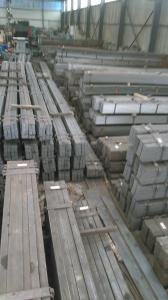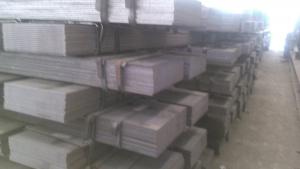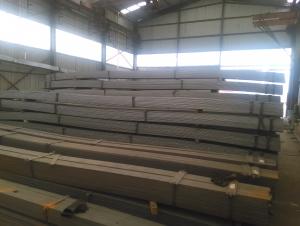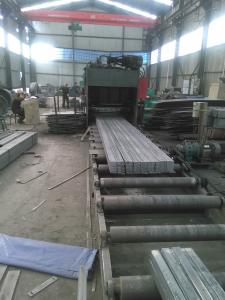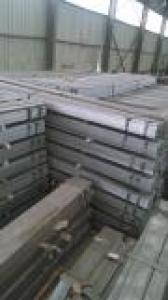Steel Flat Bars Low Carbon with Width 15mm-1250mm
- Loading Port:
- Tianjin
- Payment Terms:
- TT or LC
- Min Order Qty:
- 50 m.t.
- Supply Capability:
- 10000T m.t./month
OKorder Service Pledge
OKorder Financial Service
You Might Also Like
Product Description:
OKorder is offering Steel Flat Bars Low Carbon with Width 15mm-1250mm at great prices with worldwide shipping. Our supplier is a world-class manufacturer of steel, with our products utilized the world over. OKorder annually supplies products to African, South American and Asian markets. We provide quotations within 24 hours of receiving an inquiry and guarantee competitive prices.
Product Applications:
Steel Flat Bars Low Carbon with Width 15mm-1250mm are ideal for structural applications and are widely used in the construction of buildings and bridges, and the manufacturing, petrochemical, and transportation industries.
Product Advantages:
OKorder's Steel Flat Bars Low Carbon with Width 15mm-1250mm are durable, strong, and wide variety of sizes.
Main Product Features:
· Premium quality
· Prompt delivery & seaworthy packing (30 days after receiving deposit)
· Can be recycled and reused
· Mill test certification
· Professional Service
· Competitive pricing
Product Specifications:
Manufacture: slited
Slitting precision (width) : 0.5 mm or less
Raw material: Q235B, Q345B, Q235-1 b
crosscutting precision (length) : 2 mm or less
Processing: the thickness of 2.0-16 mm;
Shear length: 2000 mm above
Wide degree: 15-1250 - mm;
Leveling precision: 1-2 MM square
Packaging: Export packing, nude packing, bundled
Trademark | Rank | Chemical composition (quality score) % | |||||
C | Si | Mn | S | P | |||
≤ | ≤ | ≤ | |||||
Q235 | A | 0.14-0.22 | 0.30 | 0.30-0.65 | 0.050 | 0.045 | |
Q235 | B | 0.12-0.20 | 0.30 | 0.30-0.70 | 0.045 | 0.045 | |
Trademark | Rank | Pulling Test | |||||
Bend PointΔs/Mpa | Tensile Strength | Elongation Ratioδ5% | |||||
Thickness (Diameter) /MM | Thickness (Diameter) /MM | ||||||
≤16 | 16-40 | ≤16 | 16-40 | ||||
≥ | ≥ | ||||||
Q235 | A | 235 | 225 | 375-500 | 26 | 25 | |
Q235 | B | 235 | 225 | 375-500 | 26 | 25 | |
FAQ:
Q1: Why buy Materials & Equipment from OKorder.com?
A1: All products offered byOKorder.com are carefully selected from China's most reliable manufacturing enterprises. Through its ISO certifications, OKorder.com adheres to the highest standards and a commitment to supply chain safety and customer satisfaction.
Q2: How do we guarantee the quality of our products?
A2: We have established an advanced quality management system which conducts strict quality tests at every step, from raw materials to the final product. At the same time, we provide extensive follow-up service assurances as required.
Q3: what is the difference between actual weight and theoretical weight?
A3: All the section steel has two weights: actual weight and theoretical weight. Actual weight is the weighing out when the product delivered from the mill. Theoretical weight is calculated by pieces. The invoice can be based on each of them as your request.
Images:
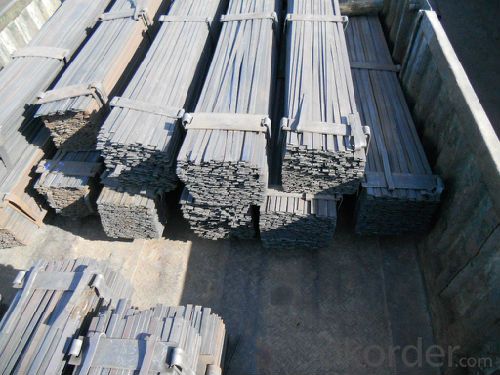
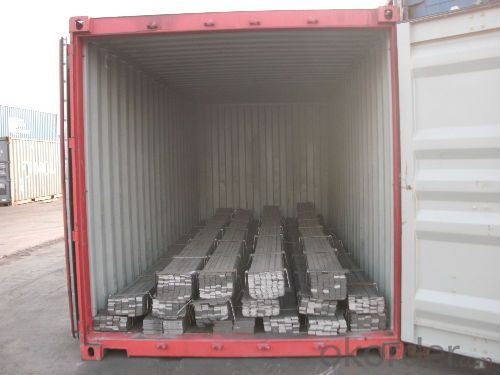
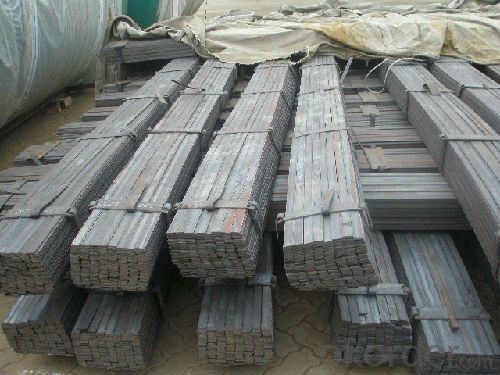
- Q:What are the common surface defects in steel flat bars?
- Some common surface defects in steel flat bars include: 1. Scale: This is a thin layer of oxide that forms on the surface of the steel during the manufacturing process. It can appear as a dark or flaky coating and can be caused by exposure to heat or chemicals. Scale can affect the appearance and surface finish of the steel. 2. Pitting: Pitting is the formation of small depressions or holes on the surface of the steel. It can be caused by corrosion, exposure to chemicals, or improper handling during manufacturing or transportation. Pitting can weaken the steel and affect its structural integrity. 3. Scratches: Scratches are shallow grooves or marks on the surface of the steel. They can occur during handling, transportation, or fabrication processes. While scratches may not affect the overall structural integrity of the steel, they can impact its appearance and may lead to localized corrosion if not properly addressed. 4. Roll marks: Roll marks are repetitive patterns or lines that are imprinted on the surface of the steel during the rolling process. They are caused by imperfections in the rolling equipment or improper adjustment of the rollers. Roll marks can affect the aesthetic appearance of the steel, but they usually do not impact its mechanical properties. 5. Inclusions: Inclusions are foreign materials or impurities that are trapped within the steel during the manufacturing process. They can appear as dark spots or irregular shapes on the surface of the steel. Inclusions can weaken the steel and affect its mechanical properties, such as ductility and toughness. It is important to note that these surface defects can vary in severity and occurrence depending on the quality of the steel and the manufacturing processes involved. Regular inspection and quality control measures are necessary to identify and address these defects to ensure the desired performance and appearance of the steel flat bars.
- Q:What does QB stand for in Q235B flat steel? What's the difference between Q235B and Q235A?
- Low alloy steel Q235A and Q235B in A, B is the difference between the level of quality (total seems to be divided into four levels, you can check and confirm), the main difference is whether it is necessary to do the normal impact test, A does not need to do, need to do B.
- Q:What are the maximum and minimum thicknesses for steel flat bars?
- The maximum and minimum thicknesses for steel flat bars can vary depending on the specific requirements and standards set by manufacturers and industry regulations. However, in general, the maximum thickness for steel flat bars can range from around 50 millimeters (2 inches) to 150 millimeters (6 inches), while the minimum thickness can be as thin as 3 millimeters (0.12 inches) or even less in some cases. It is important to consult the specific specifications and standards provided by manufacturers to determine the exact maximum and minimum thicknesses for steel flat bars.
- Q:Can steel flat bars be drilled or machined?
- Yes, steel flat bars can be drilled or machined. Steel is a versatile material that can be easily drilled or machined to create various shapes and sizes for different applications.
- Q:The total floor distribution along the wall surface 40x4 galvanized flat steel, flat paint is painted yellow mark or brush a straight chute
- Mainly to use insulating coatings.
- Q:What is the typical hardness of steel flat bars?
- Steel flat bars can exhibit varying levels of hardness, contingent upon their respective grade and heat treatment. Typically, these hardness levels span from 40 to 65 on the Rockwell hardness scale. This range of hardness guarantees the strength and durability of steel flat bars, enabling them to endure diverse mechanical pressures and impacts. Nevertheless, it is essential to acknowledge that the hardness can be tailored to meet specific application demands by means of distinct heat treatment procedures.
- Q:Can steel flat bars be used for making brackets or supports for automotive accessories?
- Yes, steel flat bars can be used for making brackets or supports for automotive accessories. Steel is a strong and durable material that provides excellent structural support. The flat shape of the bars allows for easy bending and shaping to fit specific dimensions and angles required for brackets or supports. Additionally, steel flat bars can be welded or bolted together, offering versatility in design and installation. Moreover, steel is resistant to corrosion, making it suitable for automotive applications where exposure to moisture or other elements is common. Overall, steel flat bars are a reliable and popular choice for creating brackets or supports for automotive accessories due to their strength, versatility, and durability.
- Q:How are steel flat bars made?
- Hot rolling is the technique used to produce steel flat bars. The process starts by heating a large rectangular steel billet to extremely high temperatures. Subsequently, the heated billet is passed through a series of rollers that gradually shape and flatten it into a desired rectangular cross-section with a flat top and bottom surface. During hot rolling, the billet is compressed between the rollers, exerting immense pressure and force on the steel. This pressure causes the steel to elongate and reduce its thickness, while the width remains constant. With each set of rollers, the billet is gradually shaped into the desired flat bar profile. To ensure uniformity and precision, the steel bar may undergo multiple passes through the rolling mill. The rollers are adjusted accordingly to achieve the desired thickness and dimensions. Additionally, intermittent cooling may be applied between passes to control the steel's temperature and enhance its mechanical properties. Once the desired dimensions are attained, the steel flat bar is cut to the required length. If necessary, it may undergo further processing like straightening or surface finishing. After all the necessary steps, the steel flat bar is ready for various applications, including construction, manufacturing, and fabrication. In summary, the hot rolling process plays a crucial role in the efficient and cost-effective production of steel flat bars. These versatile and widely used metal products are made possible through this process.
- Q:Can steel flat bars be used for making jewelry?
- Yes, steel flat bars can be used for making jewelry, particularly in industrial or contemporary designs where a more rugged and unconventional aesthetic is desired. However, steel is not commonly used in traditional or delicate jewelry designs due to its weight and tendency to tarnish.
- Q:What are the common methods of bending or shaping steel flat bars?
- Different methods can be used to bend or shape steel flat bars, depending on the desired outcome and the tools at hand. Here are some commonly employed techniques: 1. Cold Bending: One common method is cold bending, which involves applying force to the steel flat bar without using heat. This method is suitable for smaller bends or gentle curves. It can be accomplished manually using a vice or a specialized bending machine designed for flat bars. 2. Hot Bending: Hot bending, on the other hand, requires heating the steel flat bar to a high temperature and shaping it while it remains hot. This technique is often employed for more intricate bends or larger curves. Special equipment, like a forge or an oxy-acetylene torch, is necessary to heat the steel. 3. Press Brake: In industrial settings, a press brake machine is commonly utilized to bend or shape flat bars. This machine clamps the steel flat bar between a punch and a die, applying force to achieve the desired angle. Press brakes are versatile and can produce precise and consistent bends. 4. Roll Bending: Roll bending is an effective method for creating broad radius bends or curves in steel flat bars. It involves passing the flat bar through a set of rollers that gradually exert pressure to bend it into the desired shape. Roll bending finds applications in industries like construction and manufacturing. 5. Hammering: Hammering is a traditional technique employed for shaping steel flat bars, particularly for decorative purposes or artistic designs. It entails striking the bar with a hammer to gradually shape it. Hammering necessitates skill and precision to avoid damaging the flat bar while achieving the desired shape. It is crucial to consider factors such as the size and thickness of the bar, the desired bend radius, and the available tools and equipment when selecting a bending or shaping method for steel flat bars. Consulting with a professional or referring to specific guidelines and safety precautions is recommended prior to attempting any bending or shaping process.
1. Manufacturer Overview |
|
|---|---|
| Location | |
| Year Established | |
| Annual Output Value | |
| Main Markets | |
| Company Certifications | |
2. Manufacturer Certificates |
|
|---|---|
| a) Certification Name | |
| Range | |
| Reference | |
| Validity Period | |
3. Manufacturer Capability |
|
|---|---|
| a)Trade Capacity | |
| Nearest Port | |
| Export Percentage | |
| No.of Employees in Trade Department | |
| Language Spoken: | |
| b)Factory Information | |
| Factory Size: | |
| No. of Production Lines | |
| Contract Manufacturing | |
| Product Price Range | |
Send your message to us
Steel Flat Bars Low Carbon with Width 15mm-1250mm
- Loading Port:
- Tianjin
- Payment Terms:
- TT or LC
- Min Order Qty:
- 50 m.t.
- Supply Capability:
- 10000T m.t./month
OKorder Service Pledge
OKorder Financial Service
Similar products
New products
Hot products
Related keywords
